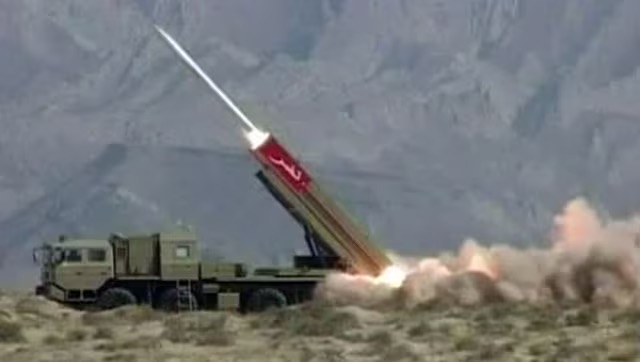Despite reeling under severe economic crisis and people of the country barely able to afford food to survive, Pakistan has not just managed to maintain its nuclear capacity, but has also doubled its arsenal than what the US estimated in the 90s. The Bulletin on Atomic Scientists in its latest report has revealed that Pakistan may now be possessing over 170 warheads, besides expanding its capacity to produce more fissile material. The report contradicts the 1999 estimates by the US intelligence that Pakistani nuclear arsenal would be somewhere between 60 to 80 warheads in 2020. “We estimate that Pakistan now has a nuclear weapons stockpile of approximately 170 warheads. The US Defence Intelligence Agency projected in 1999 that Pakistan would have 60 to 80 warheads by 2020,” the report says. Pakistan is estimated to be producing enough fissile material to build “14 to 27 new warheads per year.” “We estimate that the actual warhead increase in the stockpile probably averages around 5 to 10 warheads per year,” the report read. Expanding fissile material production capacity Fissile materials, which undergo fission reactions, are the key component of nuclear weapons or other nuclear explosive devices. Pakistan had a uranium enrichment plant in Punjab’s Kahuta and now it sees an expansion as it adds one more plant. Apart from this, there is another uranium enrichment plant in Gadwal. Four heavy-water plutonium production reactors have come up in the Khushab district of the province. A facility east of the capital Islamabad called the New Labs Reprocessing Plant which reprocesses spent fuel to extract plutonium is expanding. Another similar facility called Chashma complex in northwestern Punjab became operational in 2015 and expanded in 2018-2020. In June this year, China and Pakistan signed a $4.8 billion deal to construct a new 1,200-megawatt reactor at Chashma. Nuclear-capable missiles and mobile launchers Pakistan develops its nuclear missiles and launchers at a facility called the National Development Complex (NDC) in the Kala-Chitta Dahr Mountain range west of Islamabad. The facility is divided into two parts - the western half south of Attock, and the eastern half north of Fateh Jung. The western section is used for development, production, and test-launching of missiles and rocket engines. The eastern section produces and assembles mobile transporter erector launchers (TELs), which are designed to transport and fire missiles. In this section, new launcher assembly buildings have come up in the last decade. Pakistan Ordnance Factories near Wah, northwest of Islamabad, have bunkers in a multi-layered security perimeter. Little is out in the public domain about warhead production, but the ordnance factories, experts believe have a role. Nuclear-capable aircrafts Mirage III and V are the fighter-bombers most likely to have a nuclear delivery role. These planes are positioned at two bases: Masroor Air Base outside Karachi with three Mirage squadrons, and Rafiqui Air Base near Shorkot in Punjab with two Mirage squadrons. “A possible nuclear weapons storage site is located five kilometres northwest of the base and, since 2004, highly guarded underground facilities have been constructed at Masroor that could potentially be designed to support a nuclear strike mission. This includes a possible alert hangar with underground weapons-handling capability,” While “Mirage V is believed to have been given a strike role with Pakistan’s small arsenal of nuclear gravity bombs, the Mirage III has been used for test launches of Pakistan’s Ra’ad air-launched cruise missiles (ALCM), as well as the follow-on Ra’ad-II.” Although there is no evidence to suggest that either of the Ra’ad systems were deployed as of July 2023, one potential deployment site could eventually be Masroor Air Base in Karachi. Pakistan plans to replace the Mirages with JF-17s from China. They have acquired 100 of these already and plan on getting another 188 in the future. It has been reported that Pakistan may incorporate the dual-capable Ra’ad ALCM onto the JF-17 so that these can eventually take over the nuclear strike role from the Mirages. “In March 2023, during rehearsals for the 2023 Pakistan Day Parade (which was subsequently cancelled), images surfaced of a JF-17 Thunder Block II carrying what resembled a Ra’ad-I ALCM,” the report said. Although Pakistan is under obligation to the US to not equip its F-16s to carry nuclear weapons, the aircrafts are “most likely equipped to each carry a single nuclear bomb on the centerline pylon”. And these jets are stationed just 10 km away from the bomb storage in Sargodha. Land-based ballistic missiles Pakistan presently operates six functional ballistic missile systems with nuclear capabilities. These missiles employ solid-fuel technology and are mobile on roads. The inventory comprises the following: the short-range Abdali (Hatf-2), Ghaznavi (Hatf-3), Shaheen-I/A (Hatf-4), and Nasr (Hatf-9), along with the medium-range Ghauri (Hatf-5) and Shaheen-II (Hatf-6). Furthermore, Pakistan is actively pursuing the development of two other nuclear-capable ballistic missile systems, namely the medium-range Shaheen-III and the Multiple Independently Targetable Reentry Vehicle (MIRVed) Ababeel. The analysis of satellite imagery suggests that Pakistan maintains at least five missile bases that could serve a role in Pakistan’s nuclear forces: Arko Garrison, Gujranwala Garrison, Khuzdar Garrison, Pano Aqil Garrison, Sargodha Garrison.
The US intelligence in 1999 estimated that the Pakistani nuclear arsenal would be somewhere between 60 to 80 warheads in 2020. However, according to a new report India’s western neighbour may now be sitting over 170 warheads
Advertisement
End of Article
Written by Rakshit Sharma
Rakshit is a sub editor at Firstpost. He covers war, conflict, and international affairs. When not on the desk, he can be found either reading/listening to poetry or moving the weights. see more


)

)
)
)
)
)
)
)
)



